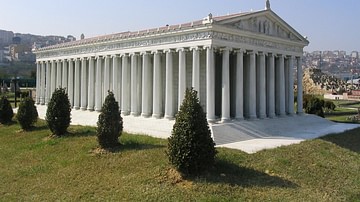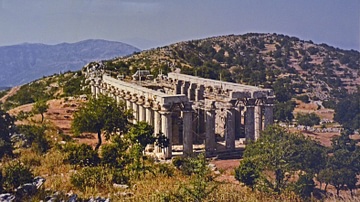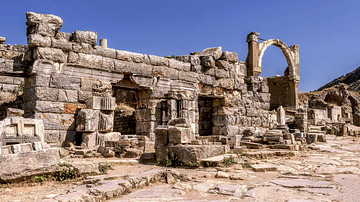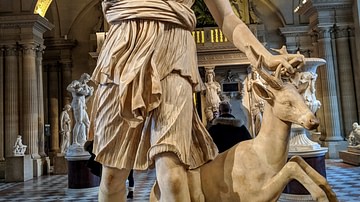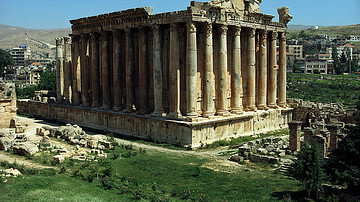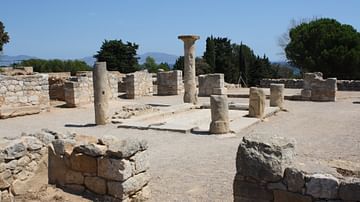
A Temple (from the Latin templum) is a structure usually built for the purpose of, and always dedicated to, religious or spiritual activities including prayer, meditation, sacrifice and worship. The templum was a sacred precinct defined by a priest (or augur) as the dwelling place of a god or gods.
The structure built at such a site was created to honor the Deus Loci (spirit) of a certain place. Early temples were constructed on sites which the people felt had a numinous quality to them which indicated the presence of a god, gods, or spirits. Some the earliest examples of these outdoor temples still extant are in Orkney, Scotland at sites such as the Ness of Brodgar. Throughout the United Kingdom, the stone circles and structures from the Neolitic Period are all known to have once been used for religious ceremonies whether on a large scale, such as at Brodgar or more modest sites like the one at Clava Cairns.
Early temples mirrored aspects of the natural world, especially mountains. The ziggurat, which defined the temple complexes of Mesopotamia, were artificial mountains as were the mounds created by the Native Peoples of North America, such as the one at Cahokia. The Mayan temples are also thought to have begun as modest outdoor sites before the rise of the great pyramid temples such as El Castillo at Chichen-Itza, another "artificial mountain" site. The word given in English as temple dates to around the 6th century BCE in reference to Roman places of worship but these sites go all the way back to before recorded history.
Gobekli Tepe Temple
The oldest known temple is that at Göbekli Tepe in southeastern Turkey which is 11,500 years old and is decorated with reliefs and pictograms of various plants and animals thought to represent the gods of that place. The temple is an extraordinary building of the Neolithic era with T-shaped pillars and engravings which have yet to be completely understood. The design of the temple, however, with a large room toward the front (possibly for public functions) is recognized in later temples from other cultures.
The Gobekli Tepe Temple's stone carvings of plants and animals suggest an animistic focus of the belief structure of those who built the site. Animism is the early religious belief that everything on earth, whether animate or inanimate, possessed a soul or intelligence which needed to be recognized and respected. This belief was shared by the Native Americans of North America, the Maya, in the Chinese belief system of Taoism and the Japanese religion of Shintoism among others. The Egyptians, to name another example, held that all of life was sacred.

Temples in Ancient Egypt
In the religious customs of ancient Egypt the temple was considered 'the horizon' of a divine being, the point at which the god came into existence at creation, and thus every sacred site had a link to the very distant past and honored the specific god whose temple it was. The temple also was a mirror of the universe and a representation of the ben-ben, the sacred mound which rose out of chaos by the will of Amon at the beginning of time. At the same time, the temple was a site set aside for communion with the gods, as at the famous temple of Karnak.
As in ancient Mesopotamia, the temple in Egypt was considered the literal home of the god to whom it was dedicated. Hathor's temple at Dendera, then, was considered her actual house and the priests and priestesses of Hathor cared for the goddess as they would a living person of flesh and blood. Every Egyptian temple followed the same basic design (thought to have been decreed by the gods themselves) of a forecourt and reception area for public gatherings with colonnades and inclines rising higher and higher to smaller and even smaller rooms until one reached the room of the Holy of Holies where the god was thought to reside when visiting earth. Only the high priest of the god of the temple could enter the Holy of Holies and commune with the deity there.
Mesopotamian Temples
Ancient Mesopotamian temples fulfilled many roles. Not only were they the house of the local deity or the patron god of the city, they were also the administrative centers of the first cities in Sumer. The city of Eridu was considered the first city in the world by the Sumerians, created by the gods after their victory of order over the forces of chaos. The origin of the decrees of civilization (the sacred meh) were thought to come from the temple there where the god of wisdom, Enki, lived.
The goddess Inanna stole the meh from Enki after a drunken party and brought them to Uruk, considered by scholars the first city in the world and once one of the largest and most prosperous. The story of Inanna bringing the meh from Eridu to Uruk is thought to symbolize the transference of power from the one city to the other and, specifically, from one temple, one sacred spot, to another.
Uruk was initially ruled by a priest-king, and it is believed that many early Mesopotamian cities followed the same model, where the temple complex with its towering ziggurat was the seat of both religious and secular authority. Even after the rise of secular kings, however, the temple was the central structure of every city throughout Mesopotamia serving as a seat of kingship, of administration, and organizing the distribution of food among the people.
The Temple in Judaism
In Judaism, the original ancient Hebrew language refers not to a temple but to a "sanctuary", "palace" or "hall". Each of the two ancient temples in Jerusalem were called Beit Hamikdash, which translates literally as "the Holy House" and, in this, the Hebrews either copied or independently arrived at the same conception of a temple that the ancient Mesopotamians and Egyptians had: that the temple was the house of the god.
The Temple Mount in Jerusalem is the site where the First Temple of Solomon and the Second Temple were built. and at the center of the temple was the Holy of Holies, where, as in Egypt, only the high priest could enter. The Greek word synagogue came to describe Jewish places of worship during the Babylonian Captivity and meant 'to gather together'. The original Hebrew names Bet Knesset ("House of Meeting") and synagogue designate Jewish temples today.
Ancient Greek Temples
Most Greek religious buildings in the modern day are referred to as "temples," but the Greek pagans (only known as pagans after the rise of Christianity) would have called a holy place a temenos, or sacred precinct. The sacredness of the place had entirely to do with the spirit of the god who resided there, not with whatever building was later constructed on the spot, as in the case of the Temple of Demeter at Eleusis, the Temple of Artemis at Ephesus or the famous Parthenon of Athens which housed the statue of Athena Parthenos (Athena the Virgin, patron goddess of the city).
The building which housed the statue, then, was sacred owing to the original presence there of, or some great deed done by, the god of that place. The Temple of Aphaia, on the island of Aegina, is only one example of the temple as home of the deity of the place. The goddess Aphaia was thought to live in the temple to personally care for the people of the island and this paradigm is evident elsewhere throughout ancient Greece.
Temples in China & India
In China, early temples honored xi'an (heaven) which represented both creation and divine order. Xi'an was the equivalent of the concept of an all-powerful deity but also heaven and the glorious home of the ancestors. Not every temple in China honored a deity, however. The Confucian Temple in the city of Qufu honors the philosopher Confucius. Built in his hometown in 478 BCE, the temple is thought to channel peace and tranquility but makes no claim to house a deity.
This is also true of Shinto temples in Japan which are always constructed in accordance with the spirits of the area and their wishes but not dedicated to, nor home of, any one particular god. The Shinto temples and shrines share a common feature with those in India where the altars are usually adorned with pictures or statues of the god or gods honored there. The significant difference is that Shinto temples honor the spirits of the place while Hindu temples revere gods, though the gods worshipped and honored are in some way associated with the area of the temple.
The interior of temples throughout India, with few exceptions, follow the basic form and structure of the temple at Gobekli Tepe which, as noted earlier, has served as the underlying paradigm for temples around the world no matter what form their facade takes. Every temple shares a liminal quality, serving as a threshold between the physical and spiritual worlds. An excellent example of this is the great temple of Angkor Wat in Cambodia which, like Karnak in Egypt, is purposefully designed as a transportive site between this world and the higher realms.
Roman Temples
In ancient Rome the rituals that located and sited the temple were performed by a high priest, an augur, who, through the observation of the flight of birds or other natural phenomena, understood the loci of the god. Roman temples usually faced east or toward the rising sun, though a notable exception is the great Pantheon which faces north (only preserved after the rise of Christianity because it was made into a church instead of being destroyed and built over, which was the fate of most pagan temples). In ancient Rome, only the deities of the Roman pantheon had a templum; any building honoring a foreign deity was called a fanum.
Visitors to Rome were welcome to worship at the fanum of their native gods but were required to worship the gods of Rome in the temples. After the rise of Christianity, the word temple, with its pagan connotations, was rejected by most Christian congregations in favor of designations such as 'church' or 'cathedral', though the word is still used by the Eastern Orthodox Church to refer to their places of worship.
Conclusion
Every civilization has erected temples in one form or another, all serving the same purpose of providing the people with a specific site at which they could commune with the higher realm of the Divine. In Norse religion, such places were usually defined by a tree or pole representing the World Tree Yggdrasil, as in the case of the famous Temple at Uppsala. The Plains Indians of North America erected temporary temples in observing the Sun Dance which was believed to awaken the earth after winter and give thanks for the gifts given by the Great Spirit.
This same paradigm is evident in modern-day temples - including the churches, mosques, and synagogues of Christianity, Islam, and Judaism - as believers come to these sites to share their faith and commune with God. In doing so, they are following an ancient tradition that predates history and is as integral an aspect of the human condition as any other.


